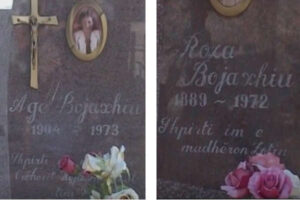Chasing the traces of Mother Theresa in Tirana
No one can doubt her origin, which is also written in black and white in all the books and her biographies. As Albanians, we are more than honored to have the same blood as Mother Teresa, the most respected Catholic nun in the world. From 4 September 2016, she has been a Saint Teresa, declared by Pope Francis during a grand ceremony at Saint Peter’s Square.
The Special Day of Mother Teresa for Albanians is the beatification day, 19 October (2003), a public holiday in the country. On this day, several activities are held to remember her values and what she gave to mankind.
Everyone already knows the history of Mother Teresa, or Gonxhe Bojaxhiu, who was born into an Albanian family in Skopje. She left her home when she was 18 years old, then lived and died in Calcutta, India. But very few know what happened to another part of her family, who lived and died here in Tirana, Albania.

If you are in Tirana, here is a pilgrimage to know that part of her life:
Mother Teresa Pavilion at the National Museum
The Mother Teresa pavilion at the National Museum is dedicated to the life and contribution of Mother Teresa to the world. In this museum, you can see photos of Mother Teresa with world personalities. There are personal belongings of Mother Teresa, which are very interesting for visitors.
One of them is a folk traditional suit of Mother Teresa, which was exposed lately in 2016. Mother Teresa visited this Museum twice when she visited Albania (1989 and 1991).

The house at Kavaja Street
The house where the Mother of Saint Teresa (Drane), and her sister (Age) lived in late ‘30 is situated at Kavaja Street, close to the Catholic Church. The owner of this Family was Avni Zajmi, of Kosovo Origin. He sheltered two women for more than 17 years.

This house is still in the same condition as it was in those years when Drane (the mother) and Age (the sister) lived. Mother Teresa also has one brother, Lazer, who served as an officer for some years in Berat and then moved to Tirana. But he emigrated early to Italy, where he created his family, and never again met his mother and sister in Tirana.
This was because, after 1945, the regime of Enver Hoxha was installed in Tirana. The border was closed for everyone, and meeting their relatives outside Albania became tough.
But this house tells a part of Mother Teresa’s family history. Some of their belongings and photos are still there. It was the first house Mother Teresa visited when she first came to Albania, Tirana, in 1989.
The last ‘shelter’
In 1963, two women of the Bojaxhiu Family moved to another apartment close to the Law Faculty in Tirana. They lived on the second floor of this building for ten years until they died.

First was Mother Drane (Rosa), who died in 1972, and only one year, desperate and in full loneliness, died the sister of Mother Teresa, Age Bojaxhiu, at 70, in 1973. Their graves are still at Sharra Cemetery, Tirana.

The mother and sister of ‘Saint Teresa’ lived for about 40 years in Tirana, Albania, in total poverty, in complete isolation, without any help from the state.
But they were so loved by the Albanian community and made many friends. Their house was always open to everyone. Today, there are many neighbors and friends who are still alive and are witnessing some memories and facts from their lives in Tirana.
The Mother Teresa square
The second largest public square in Tirana is named after Mother Teresa.
But also, the international airport outside the capital, Tirana, is named for her, as is the city’s main hospital in the town.

If you want to discover this part of the history of Mother Teresa’s family, we suggest you follow these traces.
Other News to Read
Tirana Photo Festival 2025- Mediterranean
The Tirana Photo Festival 2025 took place from June 18 to 30, 2025, in Tirana, with the theme…
What to do in July in Tirana
Welcome July! It’s time to dive into the essence of summer: Tirana is the best destination for this…
Sofra e Tiranes – the capital’s traditional festival
For 31 years, Sofra e Tiranes has been a highly anticipated event in the Tirana community.
International Tirana Photo Festival 2025 –Mediterranean
International Tirana Photo Festival 2025 –Mediterranean, 8th edition, from 18 to 30 June 2025